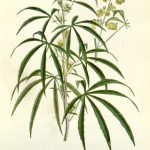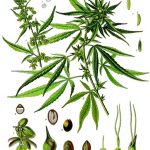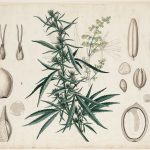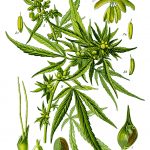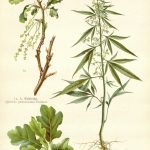The hemp family includes about 100 species in eight genera. The best known genera are hemp (Cannabis) and hops (Humulus). No genus is particularly rich in species ; hemp has only one, although there are several subspecies and varieties, and it has many different uses, for example for making rope, but also for providing oil. There are five species of hops in the world. It does not cause intoxication but was once frequently used to flavour beer.
Native to Central Asia, this plant has been used since time immemorial either in medicine (China, India, Greece…) or especially to make textiles and ropes. The first book printed by Gutenberg (a bible) was printed on hemp paper. The first jeans were cut from Nîmes hemp (shortened to denim). Once widely cultivated in Switzerland (as in the rest of the world), hemp has left its mark in many places: chènevière, canebière… In XIX e century, it occupied up to 300,000 hectares.. Its fibres were used to make clothes, sails for ships, ropes, etc. During the XX e In the 19th century, it faced stiff competition from cotton, tree cellulose and then synthetic textiles, and until the 1960s it was only cultivated for the production of special papers: thin, strong papers such as bible paper, cigarette paper and banknote paper. In recent years, there has been a revival of its cultivation: the area under cultivation has increased considerably in Switzerland. So-called monoecious varieties are grown (they have 90-95% female flowers) and selected for their fibre. Hemp is of course used in the manufacture of textiles and paper, but it is also used in the manufacture of oils, cosmetics, composite soundproofing, etc. Leading industries in various fields (automotive suppliers, sportswear, cosmetics, etc.) are interested in this old material.
Cultivated hemp is an annual herbaceous plant of the family Cannabaceae, now considered the only species of the botanical genus Cannabis, but divided into several phenotypes that can be described as subspecies and varieties. Source: Wikipedia


